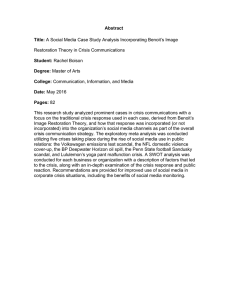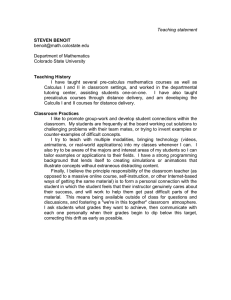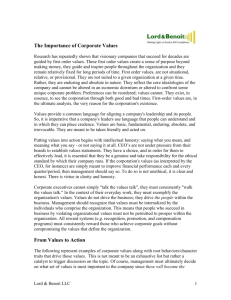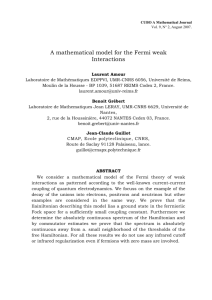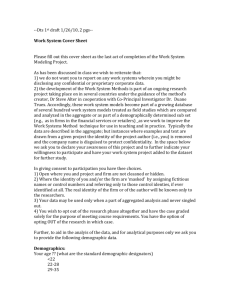Modeling Proteins Using the SE(3) Group and Analyzing Cell Motion Steve Benoit
advertisement
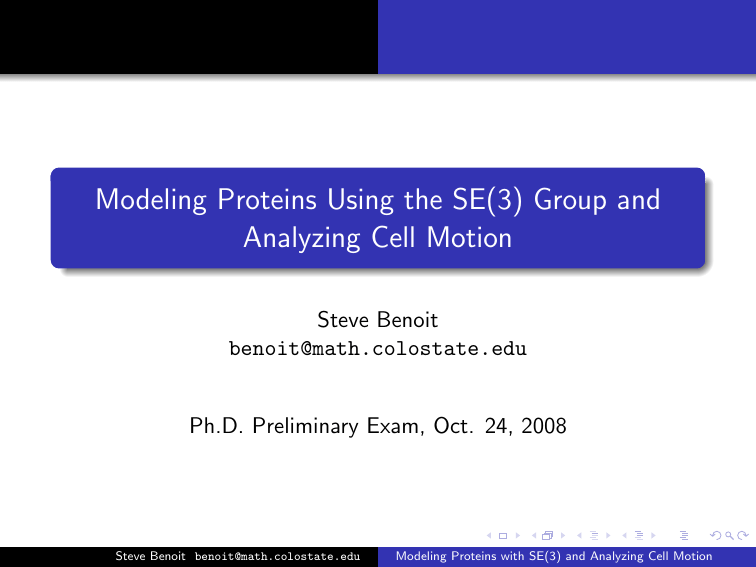
Modeling Proteins Using the SE(3) Group and Analyzing Cell Motion Steve Benoit benoit@math.colostate.edu Ph.D. Preliminary Exam, Oct. 24, 2008 Steve Benoit benoit@math.colostate.edu Modeling Proteins with SE(3) and Analyzing Cell Motion Outline 1 Modeling Proteins Using the SE(3) Group Conformation Switching Simulations Helical Structures and SE(3) Charges on Elastic Rods 2 Analyzing Cell Motion Description of the Problem Inverse Problem Regularization Extracting gradient information from data Random walk analysis Steve Benoit benoit@math.colostate.edu Modeling Proteins with SE(3) and Analyzing Cell Motion Modeling Proteins Using the SE(3) Group Part I Modeling Proteins Using the SE(3) Group Steve Benoit benoit@math.colostate.edu Modeling Proteins with SE(3) and Analyzing Cell Motion Modeling Proteins Using the SE(3) Group Conformation Switching Simulations Helical Structures and SE(3) Charges on Elastic Rods Conformation Switching Behavior Starting Point: Work by Igor Mezić Backbone with charges on rigid rods Global Morse potential produced by second backbone Torsion linkage between rods via backbone Perturbation can cause conformation switch Steve Benoit benoit@math.colostate.edu Modeling Proteins with SE(3) and Analyzing Cell Motion Modeling Proteins Using the SE(3) Group Conformation Switching Simulations Helical Structures and SE(3) Charges on Elastic Rods Conformation Switching Behavior Modifications to Model Add torsion and freedom of motion in second angular direction Conformation switching behavior is retained Steve Benoit benoit@math.colostate.edu Modeling Proteins with SE(3) and Analyzing Cell Motion Modeling Proteins Using the SE(3) Group Conformation Switching Simulations Helical Structures and SE(3) Charges on Elastic Rods Time Evolution into Helices Modifications to Model Add inter-particle interactions (Coulomb potential) Add opposing positive/negative charges Add friction dissipation Generates Helix-like structures; helicity is not constant Steve Benoit benoit@math.colostate.edu Modeling Proteins with SE(3) and Analyzing Cell Motion Modeling Proteins Using the SE(3) Group Conformation Switching Simulations Helical Structures and SE(3) Charges on Elastic Rods Helices and SE(3) Let g (t) ∈ SE (3) be given by Λ(t) r(t) g (t) = , Λ(t) ∈ SO(3), r(t) ∈ R3 0 1 Then g g −1 −1 (t) = Λ−1 (t) −Λ−1 (t)r(t) 0 1 (t)ġ (t) = Λ̇(t) ṙ(t) 0 0 b Ω(t) Γ(t) 0 0 , ġ (t) = Λ−1 (t)Λ̇(t) Λ−1 (t)ṙ(t) 0 0 Steve Benoit benoit@math.colostate.edu =: Modeling Proteins with SE(3) and Analyzing Cell Motion Modeling Proteins Using the SE(3) Group Conformation Switching Simulations Helical Structures and SE(3) Charges on Elastic Rods Helices and SE(3) b and Γ are t-invariant. Now we demand Ω Choose coordinates so the angular velocity Ω points along the z axis: 0 −ω 0 b = ω 0 0 Ω 0 0 0 Then: cos(ωt) − sin(ωt) 0 Λ(t) = sin(ωt) cos(ωt) 0 0 0 1 Steve Benoit benoit@math.colostate.edu Modeling Proteins with SE(3) and Analyzing Cell Motion Modeling Proteins Using the SE(3) Group Conformation Switching Simulations Helical Structures and SE(3) Charges on Elastic Rods Helices and SE(3) Finally, Λ−1 (t)ṙ(t) = constant and choosing orientation of x, y axes gives R ω sin(ωt) r(t) = Rω (cos(ωt) − 1) + r(0) Vt b Γ ∈ TSE (3), the set So given any fixed Ω, u ∈ R3 u = r(t), t ∈ R is a helix, and the corresponding (Λ(t), r(t)) ∈ SE (3) gives the body frame transformations of the points of the helix. Steve Benoit benoit@math.colostate.edu Modeling Proteins with SE(3) and Analyzing Cell Motion Modeling Proteins Using the SE(3) Group Conformation Switching Simulations Helical Structures and SE(3) Charges on Elastic Rods Helices as solutions to charges on an elastic rod Continuous case Continuous charge distribution along infinite elastic rod Stationary solution is helix due to invariance argument Two solutions may exist, different helicity Discrete case Molecular model: few charges per helix period Similar argument, but invariance under discrete transformations Steve Benoit benoit@math.colostate.edu Modeling Proteins with SE(3) and Analyzing Cell Motion Modeling Proteins Using the SE(3) Group Conformation Switching Simulations Helical Structures and SE(3) Charges on Elastic Rods Search for stationary solutions in discrete case Question Given a charge bouquet configuration, elastic properties of the rod, and how far apart the bouquets are attached, what are the stationary solutions for the rod conformation? Steve Benoit benoit@math.colostate.edu Modeling Proteins with SE(3) and Analyzing Cell Motion Modeling Proteins Using the SE(3) Group Conformation Switching Simulations Helical Structures and SE(3) Charges on Elastic Rods Search for stationary solutions in discrete case Question Given a charge bouquet configuration, elastic properties of the rod, and how far apart the bouquets are attached, what are the stationary solutions for the rod conformation? Solution Find force/torques corresponding to a given helix Steve Benoit benoit@math.colostate.edu Modeling Proteins with SE(3) and Analyzing Cell Motion Modeling Proteins Using the SE(3) Group Conformation Switching Simulations Helical Structures and SE(3) Charges on Elastic Rods Search for stationary solutions in discrete case Question Given a charge bouquet configuration, elastic properties of the rod, and how far apart the bouquets are attached, what are the stationary solutions for the rod conformation? Solution Find force/torques corresponding to a given helix Find helix corresponding to a given periodic force/torque Steve Benoit benoit@math.colostate.edu Modeling Proteins with SE(3) and Analyzing Cell Motion Modeling Proteins Using the SE(3) Group Conformation Switching Simulations Helical Structures and SE(3) Charges on Elastic Rods Search for stationary solutions in discrete case Question Given a charge bouquet configuration, elastic properties of the rod, and how far apart the bouquets are attached, what are the stationary solutions for the rod conformation? Solution Find force/torques corresponding to a given helix Find helix corresponding to a given periodic force/torque Find solutions where correspondences match Steve Benoit benoit@math.colostate.edu Modeling Proteins with SE(3) and Analyzing Cell Motion Modeling Proteins Using the SE(3) Group Conformation Switching Simulations Helical Structures and SE(3) Charges on Elastic Rods Derivation of force and torque Orient coordinates so reference bouquet (n = 0) has transformation I r0 g0 = 0 1 Bouquet n as seen in body frame of bouquet 0: I −r0 Λn r n Λn rn − r0 −1 hn = g0 gn = = 0 1 0 1 0 1 Vector from charge qk at point xk in reference bouquet to charge qj at point xj in the bouquet at the nth position along the helix: vnjk = hn xj − xk = Λn xj − xk + rn − r0 Steve Benoit benoit@math.colostate.edu Modeling Proteins with SE(3) and Analyzing Cell Motion Modeling Proteins Using the SE(3) Group Conformation Switching Simulations Helical Structures and SE(3) Charges on Elastic Rods Derivation of force and torque Assume a central potential u(|vnjk |) Force is Fnjk = −∇u(|vnjk |) Force acts along vector between particles We can write force as Fnjk = Gnjk vnjk , Gnjk a scalar function Linear force given by k Fnjk = (Fnjk · x̂k ) x̂k where x̂k = xk |xk | Torque given by τ njk = xk × Fnjk Steve Benoit benoit@math.colostate.edu Modeling Proteins with SE(3) and Analyzing Cell Motion Modeling Proteins Using the SE(3) Group Conformation Switching Simulations Helical Structures and SE(3) Charges on Elastic Rods Derivation of force and torque Total force and torque acting on the helix at the reference position due to inter-particle potential is: ∞ J X X Fcharge = Gnjk (vnjk · x̂k ) x̂k n=−∞ j,k=1 n6=0 τ charge = ∞ J X X Gnjk (xk × vnjk ) n=−∞ j,k=1 n6=0 Steve Benoit benoit@math.colostate.edu Modeling Proteins with SE(3) and Analyzing Cell Motion Modeling Proteins Using the SE(3) Group Conformation Switching Simulations Helical Structures and SE(3) Charges on Elastic Rods Symmetries Considering the previous expressions under exchange of indices and reflection about the origin, we obtain two symmetries: vnjk = −Λn v−nkj Gnjk = G−nkj Steve Benoit benoit@math.colostate.edu Modeling Proteins with SE(3) and Analyzing Cell Motion Modeling Proteins Using the SE(3) Group Conformation Switching Simulations Helical Structures and SE(3) Charges on Elastic Rods Helix structure corresponding to force/torque Given a particular periodic force and torque, we can derive the helix that corresponds to it. Use constant tensors to represent material elastic properties. Compute deformation of elastic rod due to point force/torques. Result is a correspondence between helix parameters ω, V , R and the force/torque expressions from prior work. Steve Benoit benoit@math.colostate.edu Modeling Proteins with SE(3) and Analyzing Cell Motion Modeling Proteins Using the SE(3) Group Conformation Switching Simulations Helical Structures and SE(3) Charges on Elastic Rods Current Status This is where I am working right now, and what the next steps are: Next steps: Six equations in three unknowns - solve (numerically?) Given tensors, find helix corresponding to torque/force Use optimization routine to find stationary solutions Look for multiple solutions with different helicities Steve Benoit benoit@math.colostate.edu Modeling Proteins with SE(3) and Analyzing Cell Motion Modeling Proteins Using the SE(3) Group Conformation Switching Simulations Helical Structures and SE(3) Charges on Elastic Rods Future Work More realistic molecular models Repeating patterns of charge bouquets Solutions with multiple periods Bouquets of bouquets Helix of helix Steve Benoit benoit@math.colostate.edu Modeling Proteins with SE(3) and Analyzing Cell Motion Analyzing Cell Motion Part II Analyzing Cell Motion Steve Benoit benoit@math.colostate.edu Modeling Proteins with SE(3) and Analyzing Cell Motion Analyzing Cell Motion Description of the Problem Inverse Problem Regularization Extracting gradient information from data Random walk analysis Description of the Problem Experimental Data Hypothesis Cell motion is inversely related to local GABA concentration. Goals of Analysis Extract cell velocities Infer local GABA concentration Deduce global GABA concentration Estimate reliability Steve Benoit benoit@math.colostate.edu Modeling Proteins with SE(3) and Analyzing Cell Motion Analyzing Cell Motion Description of the Problem Inverse Problem Regularization Extracting gradient information from data Random walk analysis Deriving Global Concentration from Local Measurements Discrete Source Model Model GABA at boundary as set of discrete point sources Number of sources must be smaller than number of samples Point sources distributed on boundary ∂Ω . Concentration Pin Ω is |r−rk | G (r) = k ak K1 λ K1 (x) is the modified Bessel function Steve Benoit benoit@math.colostate.edu Modeling Proteins with SE(3) and Analyzing Cell Motion Analyzing Cell Motion Description of the Problem Inverse Problem Regularization Extracting gradient information from data Random walk analysis Deriving Global Concentration from Local Measurements We derive a system of the form v = As where v are the velocities at the sample points, s are the source amplitudes, and A is a matrix containing the distances from each sample to each source point, scaled by the Bessel function K1 . Matrix A is not square, so we find a least-squares solution. In MATLAB, this is done with s = A\v Steve Benoit benoit@math.colostate.edu Modeling Proteins with SE(3) and Analyzing Cell Motion Analyzing Cell Motion Description of the Problem Inverse Problem Regularization Extracting gradient information from data Random walk analysis Ill-Conditioned System and Regularization Problem with this approach A is frequently nearly singular Small variation in data ⇒ large variation in solution To address this, we employ Tikhonov regularization: Begin with estimate s̄ of s Create error function P λ (s, v) = ||As − v||2 + λ||s − s̄||2 Find s that minimizes P λ (s, v) −1 T Result is s = AT A + λI A v − λs̄ Choice of λ is largely empirical Steve Benoit benoit@math.colostate.edu Modeling Proteins with SE(3) and Analyzing Cell Motion Analyzing Cell Motion Description of the Problem Inverse Problem Regularization Extracting gradient information from data Random walk analysis Regularized System, Response to Measurement Errors Recovering source amplitudes using regularized system: Steve Benoit benoit@math.colostate.edu Modeling Proteins with SE(3) and Analyzing Cell Motion Analyzing Cell Motion Description of the Problem Inverse Problem Regularization Extracting gradient information from data Random walk analysis Regularized System, Response to Measurement Errors Recovering source amplitudes using regularized system: Steve Benoit benoit@math.colostate.edu Modeling Proteins with SE(3) and Analyzing Cell Motion Analyzing Cell Motion Description of the Problem Inverse Problem Regularization Extracting gradient information from data Random walk analysis Regularized System, Response to Measurement Errors Recovering source amplitudes using regularized system: Steve Benoit benoit@math.colostate.edu Modeling Proteins with SE(3) and Analyzing Cell Motion Analyzing Cell Motion Description of the Problem Inverse Problem Regularization Extracting gradient information from data Random walk analysis Regularized System, Response to Measurement Errors Recovering source amplitudes using regularized system: Steve Benoit benoit@math.colostate.edu Modeling Proteins with SE(3) and Analyzing Cell Motion Analyzing Cell Motion Description of the Problem Inverse Problem Regularization Extracting gradient information from data Random walk analysis Regularized System, Response to Measurement Errors Recovering source amplitudes using regularized system: Steve Benoit benoit@math.colostate.edu Modeling Proteins with SE(3) and Analyzing Cell Motion Analyzing Cell Motion Description of the Problem Inverse Problem Regularization Extracting gradient information from data Random walk analysis Regularized System, Response to Measurement Errors Recovering source amplitudes using regularized system: Steve Benoit benoit@math.colostate.edu Modeling Proteins with SE(3) and Analyzing Cell Motion Analyzing Cell Motion Description of the Problem Inverse Problem Regularization Extracting gradient information from data Random walk analysis Application to Provided Data - Disaster Using experimental data Deltas between observed cell points give velocities Recover source strengths Use source strengths to project concentrations in domain Steve Benoit benoit@math.colostate.edu Modeling Proteins with SE(3) and Analyzing Cell Motion Analyzing Cell Motion Description of the Problem Inverse Problem Regularization Extracting gradient information from data Random walk analysis Extracting Data Directly from Movies Example Data Extraction Extracting frames from movie Steve Benoit benoit@math.colostate.edu Modeling Proteins with SE(3) and Analyzing Cell Motion Analyzing Cell Motion Description of the Problem Inverse Problem Regularization Extracting gradient information from data Random walk analysis Extracting Data Directly from Movies Example Data Extraction Extracting frames from movie Frame Smoothing Steve Benoit benoit@math.colostate.edu Modeling Proteins with SE(3) and Analyzing Cell Motion Analyzing Cell Motion Description of the Problem Inverse Problem Regularization Extracting gradient information from data Random walk analysis Extracting Data Directly from Movies Example Data Extraction Extracting frames from movie Frame Smoothing Identification of Cells Steve Benoit benoit@math.colostate.edu Modeling Proteins with SE(3) and Analyzing Cell Motion Analyzing Cell Motion Description of the Problem Inverse Problem Regularization Extracting gradient information from data Random walk analysis Extracting Data Directly from Movies Example Data Extraction Extracting frames from movie Frame Smoothing Identification of Cells Motion Extraction Steve Benoit benoit@math.colostate.edu Modeling Proteins with SE(3) and Analyzing Cell Motion Analyzing Cell Motion Description of the Problem Inverse Problem Regularization Extracting gradient information from data Random walk analysis Extracting Data Directly from Movies Example Data Extraction Extracting frames from movie Frame Smoothing Identification of Cells Motion Extraction Trajectory Extraction Steve Benoit benoit@math.colostate.edu Modeling Proteins with SE(3) and Analyzing Cell Motion Analyzing Cell Motion Description of the Problem Inverse Problem Regularization Extracting gradient information from data Random walk analysis Random-Walk Analysis and Results Hypothesis Hard to get consistent velocity data from trajectories Trajectories resemble random walks Hypothesis: Random walks + “drift” Steve Benoit benoit@math.colostate.edu Modeling Proteins with SE(3) and Analyzing Cell Motion Analyzing Cell Motion Description of the Problem Inverse Problem Regularization Extracting gradient information from data Random walk analysis Random-Walk Analysis and Results Steve Benoit benoit@math.colostate.edu Modeling Proteins with SE(3) and Analyzing Cell Motion Analyzing Cell Motion Description of the Problem Inverse Problem Regularization Extracting gradient information from data Random walk analysis Future Work Include more empirical data in analysis Extract drifts as averages over trajectories Steve Benoit benoit@math.colostate.edu Modeling Proteins with SE(3) and Analyzing Cell Motion Modeling Proteins Using the SE(3) Group and Analyzing Cell Motion Steve Benoit benoit@math.colostate.edu Ph.D. Preliminary Exam, Oct. 24, 2008
